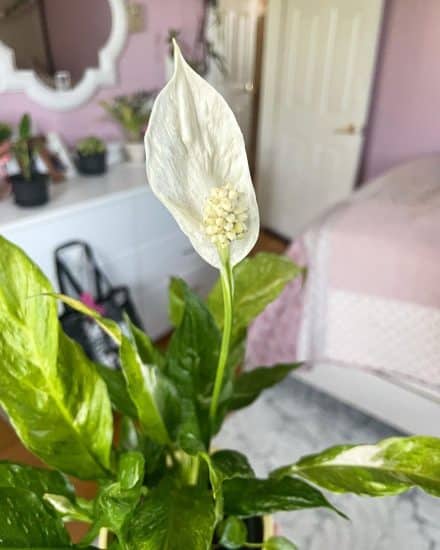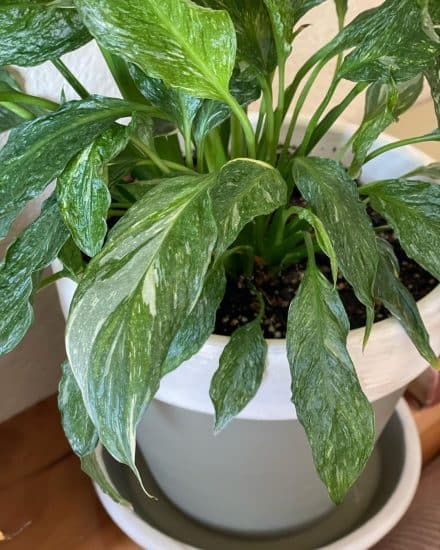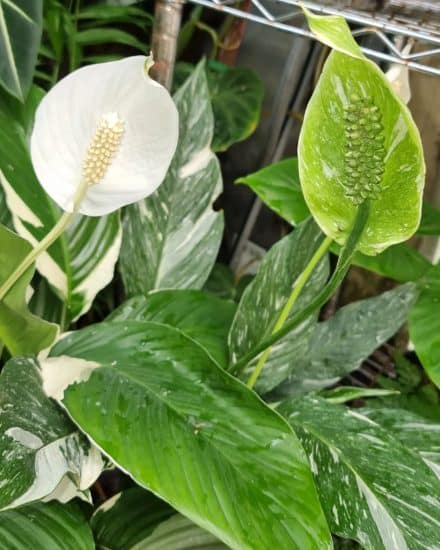The striking white and green leaves of the Domino Peace Lily look way harder to take care of than they actually are.
Wait. Something that fancy-looking can actually be low-maintenance? You bet.
In fact, the Domino Peace Lily (Spathiphyllum wallisii ‘Domino’) is a gorgeous, easy care houseplant that practically everyone can grow — even if you don’t have the greenest thumb on the block.
From watering tips to the perfect lighting conditions, we’ve got useful tips for all aspects of Domino Peace Lily care. So, even if your houseplant history is more “tragic” than “magic,” don’t worry — you’ve got this. Let’s get growing!
Table of Contents
Domino Peace Lily Plant Care Guide
History, Habitat, and Characteristics

Domino Peace Lily (Spathiphyllum wallisii ‘Domino’) is the variegated version of the common peace lily. This popular houseplant is known for the striking white fleckings on its leaves and crinkly foliage. And we can’t forget those beautiful blooms!

Domino Peace Lilies are part of the Spathiphyllum family, closely related to their anthurium cousins. While anthuriums have consecutive blooms throughout the year, peace lily plants typically bloom once a year between January and August.
The variegated leaves of the Domino Peace Lily make it distinctive from other peace lily varieties, such as the Spathiphyllum Picasso, which has Dalmatian-style white splotches. Their stunning creamy white spathes occasionally showcase green streaks, adding pizzazz to their appearance.
People (me included) love this plant not only for its unique looks but also for its low-maintenance nature. It thrives in the dappled sunlight and high humidity of the understory in tropical rainforests. It’s easy to mimic this plant’s native environment indoors — your house is probably already the perfect temperature for it to thrive.
Fun fact: The Domino Peace Lily doubles as an air-purifying superhero! According to NASA research, it helps improve air quality.
(Maybe a good choice for the bedroom?)
Light

When it comes to the Domino Peace Lily’s lighting needs, it’s important to take its native habitat into account.
The Domino Peace Lily naturally thrives in tropical rainforests of South America, where it enjoy low to medium light conditions. It’s often under 30% shade in greenhouses.
As variegated plants, peace lilies need more bright indirect light than non variegated plants. It’s worth knowing that the variegated peace lily can tolerate lower lighting . . . but it does benefit from more bright indirect light to enhance its variegation.
Now, if your variegated peace lily is getting too much sunlight, you might see yellow leaves, burnt leaf tips, or the colors fading in the plant’s foliage. If you do, simply move the plant to a more shaded spot, or use a sheer curtain to filter the sunlight’s intensity.
Conversely, if your variegated peace lily isn’t receiving enough light, it could show signs like slow growth, leggy stems, and a decrease in variegation. To fix this, try relocating the plant to an area with more bright indirect light.
Alternatively, you can use artificial lighting (like an LED grow light) to supplement its needs and maintain the attractive variegation it’s known for. The right lighting will help keep your plant healthy and beautiful!
Water
Caring for a Domino Peace Lily requires striking the right balance in its watering routine. Keep the plant’s soil consistently moist, avoiding both soggy conditions and dry spells.
To determine when to water your peace lily plant, regularly check the soil moisture by sticking your finger into it. If the soil feels moist, refrain from watering it. If it feels dry, give it a generous drink.
Water more frequently in the early spring and summer months. However, rely on the soil’s moisture level rather than maintaining a rigid schedule.
Not receiving enough water: Look out for wilting and curling green leaves, as well as browning leaf tips. These are indicators that your variegated peace lily needs more water. Remove dying leaves to avoid attracting pests and increase your watering frequency.
Receiving too much water: Symptoms of overwatering include brown spots on leaves, mushy stems, and constantly damp soil. If you notice these signs, cut back on watering and allow the soil to dry before the next watering session.
Ensure you’re using a well-draining pot with a drainage hole to prevent issues caused by excess water.
Temperature and Humidity

Temperature plays a crucial role in the the growth and flowering of the Domino Peace Lily. Aim for a cozy environment with normal household temps (65-80°F) with night temperatures that don’t dip below 55°F.
Peace lilies grow best in environments without drastic temperature changes or cold drafts, since these can stress them out and damage their pretty green leaves. Watch for wilting or drooping leaves, which can signal temperature issues.
Too much heat may cause yellow or brown spots, while too little heat can lead to dark, waterlogged spots on the leaves.
Humidity is equally important for the variegated peace lily domino. It prefers high humidity but can tolerate average humidity conditions. Look for humidity levels around 40-60% for optimal growth.
If humidity is too low, you might see brown tips on the leaves, but not the entire leaf crisping up. Positioning the plant in a bathroom and taking regular showers can provide adequate humidity. Drooping leaves or browning tips can indicate low humidity levels.
To raise humidity for your peace lily plants:
- Place your Peace Lily Domino on a tray with water and pebbles, increasing moisture near the plant.
- Set up a humidifier close to the plant to maintain a consistent humidity level.
- Group your variegated Peace Lily Domino with other favorite houseplants, allowing them to share moisture through transpiration.
- Mist the plant’s green leaves with water to wipe off dust and potential pests, but remember to clean the leaves afterward to avoid excess moisture issues.
Soil and Planting

As low maintenance houseplants, peace lilies need good aeration.
The base of your potting mix should be a high-quality regular soil. This will make up the majority of the mix, providing essential nutrients and moisture retention for your variegated peace lily. It creates the right foundation for your plant to thrive, ensuring it receives the nutrients it needs to grow healthily.
To promote aeration and proper drainage, you’ll also need to add perlite or cactus soil to the mix. These elements should make up about 1/4 of the total soil composition.
Perlite is a lightweight, volcanic rock that prevents the soil from becoming too compact and allows the roots to breathe.
Cactus soil, on the other hand, is specifically designed to promote good drainage and prevent overwatering which can be beneficial for peace lilies.
Fertilizing
When it comes to fertilizing your variegated peace lily, it can benefit from extra nutrients during the growing season.
Use a balanced liquid houseplant fertilizer at half strength and apply it every month during spring and summer. But remember to give your peace lily a break during the winter months since it will be dormant and won’t need the extra nutrients.
Avoid over-fertilizing, as it can lead to problems like slow growth or burnt leaf tips.
Repotting variegated peace lilies might be necessary every two to three years, or when you notice their roots are outgrowing their current container.
When repotting, select a pot that’s only slightly larger than the previous one and ensure there are drainage holes located at the bottom.
Gently remove the plant from its current pot (taking care not to damage the roots) and place it in the new pot. Fill in the gaps with your soil mix (3/4 regular soil and 1/4 perlite/cactus soil) and water lightly to help the plant settle in its new home.
Propagation

Propagating a variegated peace lily is a fun and rewarding way to create new plants for your home or to share with friends. Division is your go-to method since these plants have rhizomes, like ZZ plants and Caladiums.
Propagating Domino Peace Lily by division:
- Pick a healthy stem: Search for a stem with new leaves or growth on your variegated peace lily. This helps ensure you choose the best baby plant that’s ready to grow on its own.
- Carefully remove soil around the stem: Now it’s time to reveal the roots and rhizomes. Gently remove the plant’s soil near the stem you picked, making sure not to damage the roots. Remember, healthy roots are vital for successful propagation.
- Detach the baby plant: Take a clean, sterilized pair of gardening shears or scissors and separate the baby plant from the main plant. Check that the baby plant has a healthy root system before moving on.
- Pot it up: Place the baby plant into well-draining potting mix and set it in a bright spot with indirect light, such as an east-facing window. Keep the soil consistently moist as your new plant gets settled.
Our propagation tips:
- Try to propagate your variegated peace lily in the growing season (spring or summer) for the best results.
- Be patient! It might take a few weeks for your baby plant to establish itself and show signs of new growth.
- When choosing the new pot, make sure it has proper drainage to avoid root rot and keep your plant happy and healthy. Consider using a mix of potting soil, perlite, and orchid bark for best results.
Common Issues

Variegated peace lilies, including the Domino variety, are generally low-maintenance plants, but they can still face some challenges.
Brown Leaf Tips
Brown leaf tips on your variegated peace lily could be a sign of underwatering or low humidity. When the plant doesn’t get enough water, the leaves can become stressed, resulting in those unsightly brown tips.
To tackle this issue, water your peace lily consistently, allowing the top inch of soil to dry out between waterings (remember, overwatering can also be harmful).
Additionally, make sure your peace lily is in an environment with adequate humidity. You can boost humidity levels by misting the leaves, using a humidifier, or placing a tray of water near the plant.
Low humidity can also lead to the buildup of dirt and debris on the crinkly leaves of variegated peace lilies (it’s particularly noticeable in bathrooms or other areas with limited air circulation). Keep your plant looking its best by gently wiping down the leaves with a damp cloth from time to time to remove any dirt and debris.
Yellowing Leaves
Yellowing leaves on a variegated peace lily often indicate overwatering. Too much water can cause root damage, which, in turn, leads to yellow leaves that may eventually fall off.
To fix this issue, make sure you’re watering the plant just enough and letting the top inch of soil dry out between waterings.
Check that your pot has proper drainage holes, and if the problem persists, consider repotting your peace lily into fresh soil that offers better drainage.
A green-streaked spathe on your variegated peace lily might raise some concerns, but it could simply be a sign of aging or a natural variation in the cultivar. The return of chlorophyll to the spathe allows the plant to harvest more light . . . which is actually beneficial and not a cause for concern!
Pests and Diseases

Domino Peace Lilies are usually strong and sturdy, but every now and then, they might face a few pesky pests like scale insects and fungus gnats.
Root Rot
Rotting roots can sneak in when soil stays moist for too long, leading to the decay of your plant’s roots. If you see your peace lily’s leaves turning yellow or wilting, it might be time for a root check.
To fix root rot, gently remove the plant from its pot and take a look at the roots. If you find any squishy, brown, or black ones, snip them off with sterilized scissors.
Make sure the soil drains well and add perlite, pumice, or LECA for better aeration. Pop the plant into fresh soil with added organic matter. Let the soil dry out before you water your plant again, allowing it to recover and maintain a healthy root system.
To prevent root rot, give the soil time to dry out between waterings. Poke your finger about an inch into the soil to check for moisture before you water your plant.
If the issue persists, think about repotting the plant in new soil to improve its overall health and avoid fertilizing.
Fungus
Fungal infections are rare in peace lilies, but they can happen. Keep an eye out for white, circular patches on the leaves and stems.
To treat a fungus problem, keep the infected plant away from your other plants. Remove the affected leaves and stems, then treat the plant with a fungicide (follow the label’s instructions).
Wipe the plant’s leaves regularly with a damp cloth or rubbing alcohol to help keep the fungus away.
Pests
Your peace lily might sometimes attract common houseplant pests like spider mites, mealybugs, aphids, or scale insects. Check the undersides of the leaves and around the stems for tiny bugs or sticky sap.
To handle these unwanted visitors, separate the affected plant from your other houseplants to stop the pests from spreading. Use a damp cloth to wipe the leaves and stems, removing the pests.
For serious infestations, go for an indoor-plant-safe insecticide and follow the directions on the label.
Conclusion

That’s a wrap for our Domino Peace Lily care guide!
From its unique variegated leaves to its air-purifying abilities, the Domino Peace Lily is a true gem of a plant. It’s one of those houseplants that looks like a diva but doesn’t actually have many demands.
Domino Peace Lily care summary:
- Thrives in bright, indirect sunlight but can tolerate lower light conditions as well.
- Provide a comfortable environment with temperatures around 68°F (20°C) and humidity levels between 40-60%.
- Use a well-draining soil mix made up of regular potting soil and perlite or cactus soil.
- Fertilize with a balanced liquid houseplant fertilizer at half strength during the growing season.
- Repot every 2-3 years or when roots outgrow their current pot.
- Be vigilant about pests and address any issues promptly to maintain a healthy, happy plant.
We hope this guide has equipped you with the knowledge and confidence to nurture your Domino Peace Lily.
Don’t hesitate to reach out if you have any questions or need additional guidance. Enjoy your new foliage friend, and may your indoor garden flourish!
Happy planting!
FAQ
Is Domino Peace Lily rare?
While all variegated peace lilies are less common than non variegated ones, Domino Peace Lily is the most common variegated peace lily. It will often be available at your local nursery or plant store. More rare variegated peace lilies include Picasso and White Stripe.
How much light does a Domino Peace Lily need?
While it prefers medium to bright indirect light, Domino Peace Lily can still grow in low light settings. Keep in mind that it may lose some of its variegation without more light, however.
What is the difference between Peace Lily Jet Diamond and Domino?
Jet Diamond Peace Lily is a newer version of Domino Peace Lily that’s easier to grow, with variegation that’s more stable. It’s got green leaves with whitish silver streaks and puts out all white blooms.


